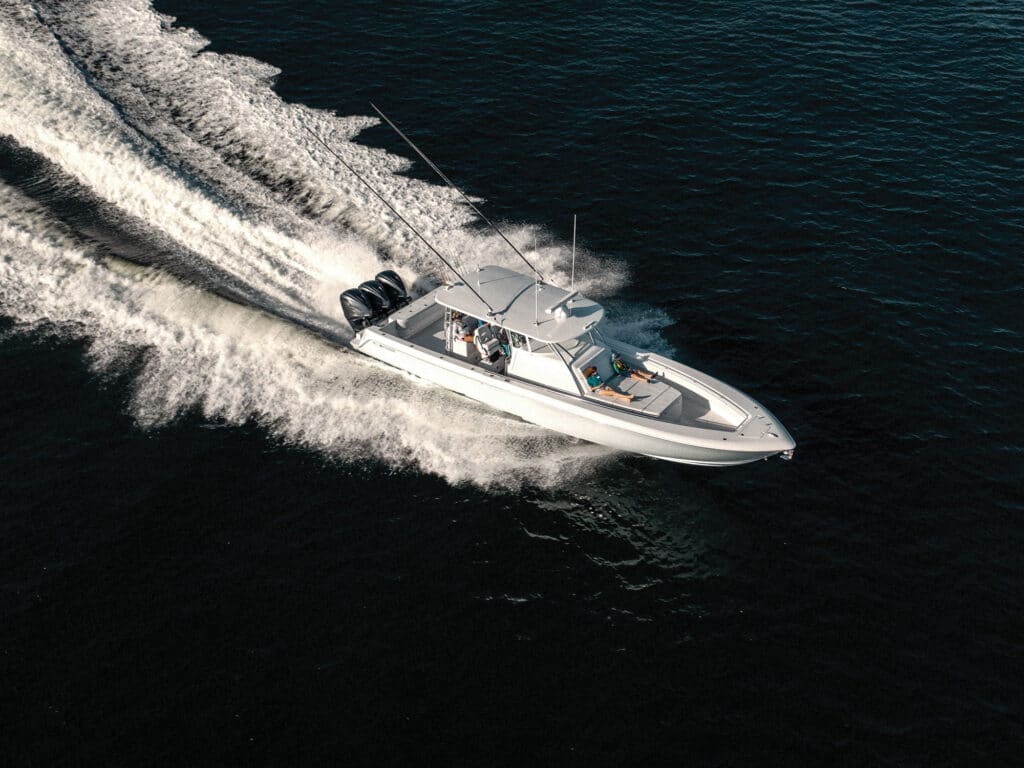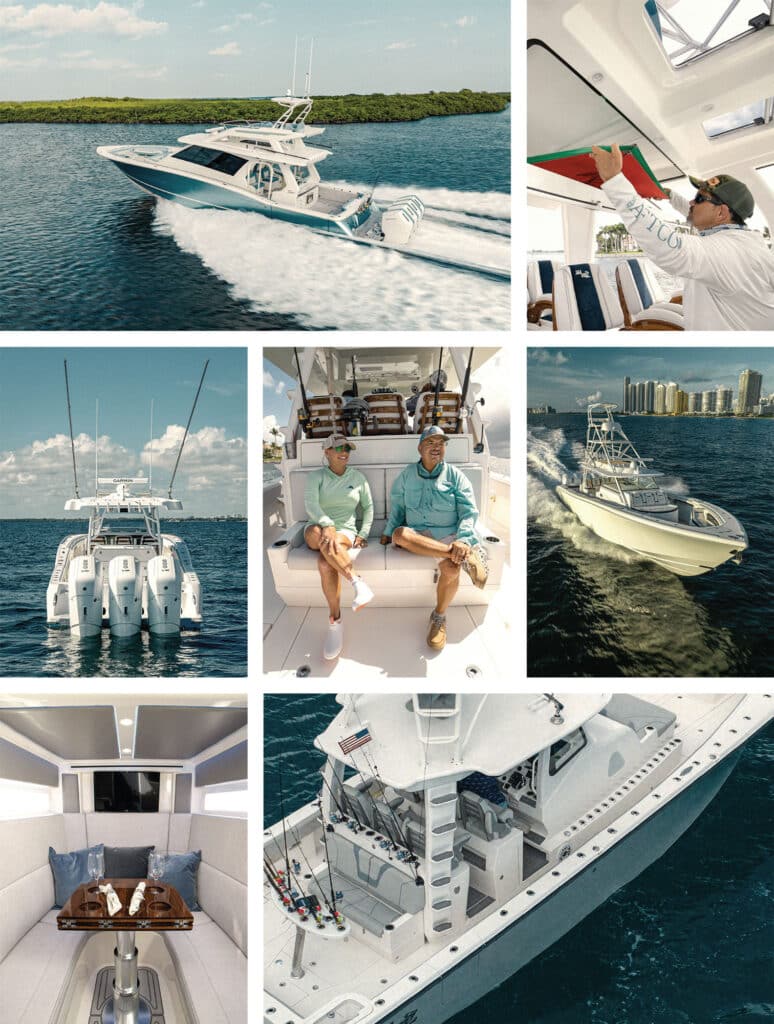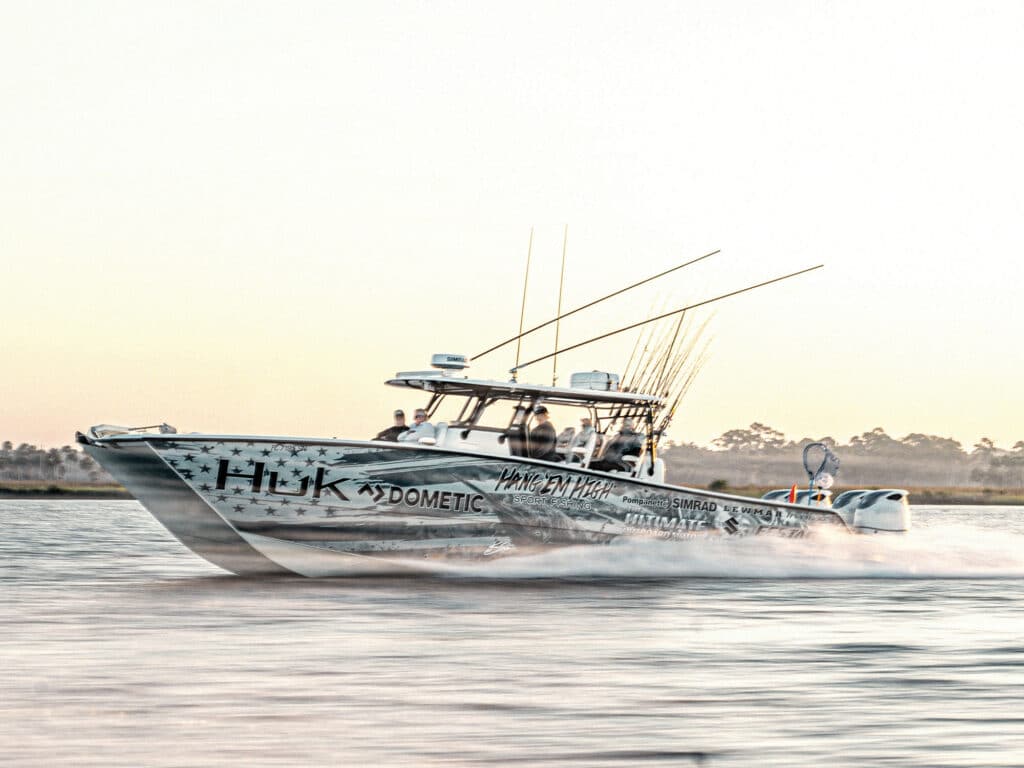
I remember when a run to the offshore fishing grounds went something like this: Get to the boat the night before to load up gear, bait and tackle. Once we cleared the breakwater, we’d settle in for a long, slow chug through the inky darkness. If there was any weather, the inability to see approaching waves meant slowing down even more. After eight or 10 hours of creeping along and taking turns at the helm, a faint horizon would materialize along the hem of the purple-gray sky, and our fishing day would officially begin.
Today a new breed of high-speed fishing boats has created a new paradigm for serious offshore anglers coast to coast. Owners of these powerful fishing machines are likely to hop on board in the morning, fire up the four or five high-performance outboards sitting shoulder-to-shoulder across the ample transom, and motor out of the harbor to the oohs and aahs of onlookers and envious anglers.
When the captain reaches open water and opens the throttles on up to 3,000 hp of outboard power, the true appeal of these speed machines becomes apparent. With a jaw-dropping amount of available horsepower, high-tech mono- or multihulls rocket to the offshore destinations in a fraction of the time required in yesteryears. The concept of comfortably running 100 miles or more, catching a load of fish, and returning home on the same day is not just possible but also common.
Fishing-boat brands such as Contender, Freeman, Invincible, Regulator, Scout, SeaVee, Yellowfin and others have broken the mold on what a center-console outboard-powered fishing boat can achieve, blasting through size and performance barriers. This new crop of boats offers the dimensions and seaworthiness of old-fashioned sport-fishing yachts, but can also reach 60 mph and cruise all day at 40 to 50 mph without breaking a sweat. And they do this with surprisingly good fuel economy, providing the range to go long and fish hard all day.
However, there’s a lot more to this new class of boats than just size and speed. Boatbuilders are competing to introduce more comfortable and capable offshore machines, adding new features, interior comfort and amenities without compromising on the open layout and unfettered fishing access that define the breed. Owners are attracted by these vessels’ versatility as well. These boats can be supersize (with corresponding price tags well over $1 million), but a center-console is still a center-console. If the mood strikes, owners want the ability to pull up on a sandbar with everybody else, kick back with a drink, and enjoy the party with their smaller cousins.
When you first see one of these sleek and stylish boats, your eyes are inevitably drawn to the gleaming engine cowlings seemingly filling every inch of transom space. It’s clear that the entire class of vessels couldn’t exist without quantum leaps in outboard motor power and technology from builders like Mercury, Suzuki and Yamaha. There are different theories about which came first, this growing number of high-powered outboards from 350 to 600 hp, or the ever-larger hulls designed for outboard power. Conventional wisdom is that the evolution of more-powerful outboards led to the development of wider, longer and more-advanced hulls. However, there are also those who believe that evolving consumer demand for simplicity and ease of use was simultaneously pushing builders to redefine the center-console and walkaround fishing-boat classes.
Perhaps we should call it a tie. “The evolution of outboard motors has resulted in even more-powerful, reliable and feature-rich powerplants, enabling boat sizes in this popular segment to grow to overall lengths of 40 feet and beyond,” says John Caballero, sales and marketing director for SeaVee Boats. At the same time, he acknowledges an existing preference for simpler boats. “The market discovered long ago how practical a center-console boat is in terms of its utility and generally lower maintenance requirements.” He highlights the company’s 42-foot 420Z and 45-foot 450Z as ideal models for meeting this need, providing the amenities to enhance the fishing experience and the safety and comfort for all on board. Additionally, both models can be highly customized to suit the owner’s needs and preferences.

“While supersize center-consoles are by no means simple machines, they are undoubtedly less complex than multistateroom sport-fishing yachts,” says Rob Sabin, southeast sales manager for Contender Boats. “This typically translates to lower maintenance bills and less time in the yard. It also gives owners the ability to run and maintain their own vessel.”
Contender considers its 44-foot 44FA (Fisharound) the perfect fishing platform for extended adventures. Built on the center-console 44ST hull, the 44FA features a large berth, enclosed head and kitchenette. It carries 575 gallons of fuel along with 70 gallons of fresh water and can be equipped with a generator, air conditioning, ice makers, water heaters and gyrostabilization.
“Boats are getting bigger and more powerful, but that’s not all,” says Matt Arnholt, marketing manager for Yellowfin Yachts. They have been able to maximize efficiency and fishability while incorporating various features, electronics in particular, Arnholt points out.
While the 36 Offshore continues as Yellowfin’s most popular model, anglers are also turning to the 39 Offshore, 42 Offshore and 54 Offshore, Arnholt observes. The 54 delivers the brand’s styling, stepped hull, fuel efficiency and construction with features like a fully equipped galley, queen berth and a diesel generator. Its long list of available options includes a bow thruster, a Quick dynamic stabilizer, and a range of hardtop and tower possibilities.
“Many of our customers used to own large sport-fishermen,” says Alan Lang, director of sales and marketing for Scout Boats. “They are ready to move to a center-console for the ease of operation and the ability to drive it themselves and take care of it themselves. Outboard power not only makes our boats fast and agile, it also makes maintenance much easier.” Multiple high-horsepower engines also provide owners with peace of mind. According to Lang, Scout’s current flagship—the 530 LXF—will easily get on plane and get you home at 50 mph, even with one engine down.
Scout raised eyebrows across the industry when it first previewed its 670 LXF, a 67-foot LOA cross between a center-console and a superyacht due for launch in 2024. Scout’s 530 LXF (Luxury Fish) is a 53-footer built almost entirely of lightweight yet strong carbon fiber and epoxy resin, and it’s packed with amenities like dual hydraulic beach platforms that lower for family water play, heated helm seats, a standard Seakeeper gyrostabilizer and luxurious interior options.

“The biggest things driving these supersize center-consoles are high horsepower, along with the great weight-to-horsepower ratio,” says Dan Freer, senior director of engineering for Invincible, which offers both monohull and catamaran models.
Invincible’s 46-foot cat is offered in both a center-console and pilothouse configuration. Even with the added comforts of two sleeping berths, interior seating, air conditioning and a generator, the 46 Pilothouse stays true to the brand with 360-degree fishability. The new flagship of Invincible’s monohull fleet is the 43 Open Fisherman. While the cockpit layout emphasizes all-around fishing room, the design includes a cabin with a full sleeping berth, a vanity sink and a head for extended angling journeys.
Builders pretty much agree that the trend will continue, even if the overall size of the boats eventually tops out. Consumer demand and outboard engine development will continue to drive future innovation. What this future will look like is anyone’s guess, but it will certainly be a hell of a ride.
Outboard Muscle
Powerful and efficient outboards are helping drive the trend for larger boats. Here are the top dogs in horsepower from three manufacturers.
Mercury: The Mercury V-12 600 hp and Mercury Racing 450R and new 500R are popular choices for twin, triple, quad and even quintuple installations.
Suzuki: Suzuki’s V-6 DF350 pioneered twin contra-rotating propellers for the added torque to push heavy loads, making this 350 a solid and efficient choice for catamarans in quad applications.
Yamaha: Yamaha’s new V-8 450 XTO Offshore outboard is a popular power option for the new breed of XL-size open fishing boats.










